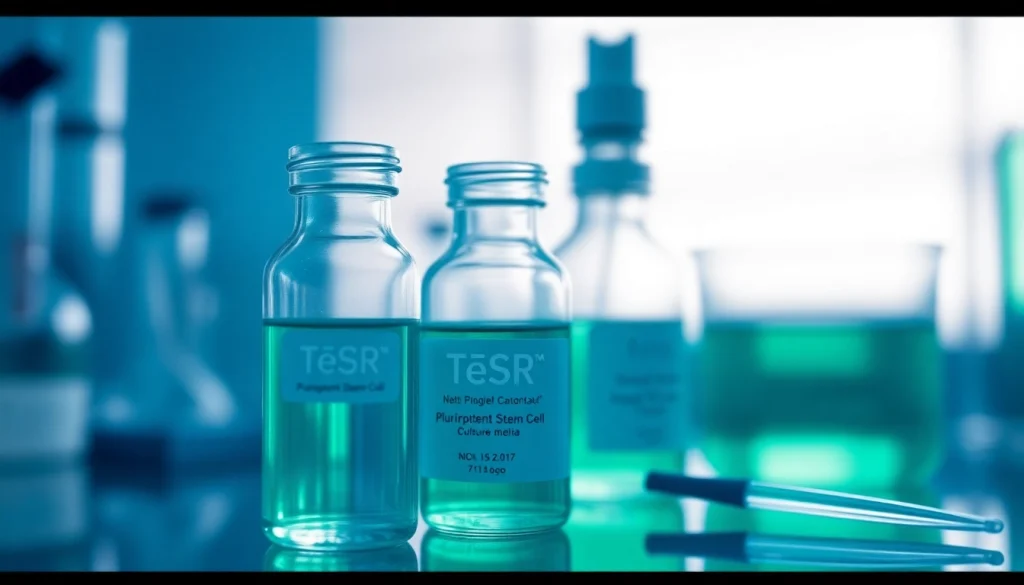
Understanding TeSR™ Feeder-Free Media
The world of stem cell research has seen remarkable advancements, particularly with the advent of TeSR™ feeder-free media that have transformed the culture conditions for human pluripotent stem cells (hPSCs). This unique and versatile family of media enables researchers to work with embryonic stem cells (ES) and induced pluripotent stem cells (iPS) in a robust, xenobiotic-free environment without the dependency on feeder layers, thus minimizing variability and optimizing results. The comprehensive use of TeSR™ media can streamline processes from cell reprogramming to maintenance, differentiation, and even cryopreservation. For detailed insights and applications of these media, you can explore our website, all check. This article will delve deeper into understanding TeSR™ media, their variations, and best practices for maintaining high-quality hPSC cultures.
What is TeSR™ Media?
TeSR™ media is a family of defined, serum-free formulations developed specifically for the culture of human pluripotent stem cells. Originating from the laboratory of Dr. James Thomson, the pioneer in stem cell research, these media have been formulated to provide optimal growth conditions for hPSCs while ensuring high rates of pluripotency. The media support the maintenance and expansion of hPSCs in a controlled environment that mitigates the risks typically associated with feeder-dependent cultures.
Key Benefits of Feeder-Free Culture
Utilizing feeder-free cultures provides several advantages over traditional methods:
- Improved Consistency and Reproducibility: TeSR™ media deliver batch-to-batch consistency, which is crucial for results that researchers can rely upon in experimental settings.
- Reduced Risk of Contamination: By eliminating feeder layers, the risk of introducing unknown variables and contaminants is significantly reduced, allowing for clearer interpretation of experimental outcomes.
- Enhanced Control Over Culture Conditions: Feeder-free systems enable precise control over the cellular microenvironment, facilitating tailored experiments in differentiation and reprogramming.
- Simplified Protocols: Researchers benefit from simplified protocols, reducing time and effort spent on media preparation and cell handling.
Common Applications in Research
TeSR™ feeder-free media are utilized across a spectrum of applications, including:
- Maintenance and expansion of hPSCs for various experiments.
- Reprogramming somatic cells into pluripotent stem cells.
- Differentiation into specialized cell types, such as cardiomyocytes, neurons, and hematopoietic cells.
- Cryopreservation techniques to ensure long-term storage of viable stem cell lines.
Variations of TeSR™ Media
Overview of Available Formulations
The TeSR™ media family includes various formulations, each tailored to specific research needs:
- TeSR™-E8™: A low-protein maintenance medium that simplifies cell culture while maintaining pluripotency.
- mTeSR™ Plus: Offers enhanced pH buffering capabilities, levelling the ground for consistent cell maintenance.
- TeSR™-AOF: An animal origin-free formulation, providing enhanced safety against viral contamination.
- mTeSR™1: The original formulation, widely celebrated for its efficacy in maintaining ES and iPS cells.
Comparative Analysis: mTeSR™ Plus vs. mTeSR™1
While both mTeSR™ Plus and mTeSR™1 share foundational components, they differ in critical ways:
- pH Buffering: mTeSR™ Plus integrates advanced buffering technology, stabilizing the culture environment for extended periods.
- Handling Flexibility: mTeSR™ Plus allows researchers to maintain cultures on a weekend-free schedule, reducing the burden of repetitive media changes.
- Stability of Components: mTeSR™ Plus includes stabilized components, enhancing overall culture performance and cell quality.
Specialized Solutions for iPS Cell Reprogramming
TeSR™ media have been formulated to support diverse reprogramming methodologies:
- ReproTeSR™: A unique medium developed for effective reprogramming of fibroblasts and blood cells into iPS cells.
- TeSR™-E7™: Specifically optimized for reprogramming human fibroblasts, assisting in quality iPS generation.
Maintaining High-Quality hPSC Cultures
Importance of Consistency in Research
For researchers working with hPSCs, consistent and quality cultures are critical. Variability can lead to aberrant behavior in stem cells, resulting in unreliable data and reproducibility issues. Adopting TaSR™ protocols ensures that such inconsistencies are minimized, thereby ensuring that experimental results are reflective of true biological phenomena.
Quality Control Measures in TeSR™ Media
STEMCELL Technologies implements rigorous quality control measures during the production of TeSR™ media:
- Pre-screened Raw Materials: All materials utilized are pre-screened to ensure their reliability and suitability for culture systems.
- Batch Testing: Regular batch testing is performed to confirm that each lot meets stringent performance criteria.
- Supplier Audits: Audits of suppliers are regularly conducted to ensure the ongoing quality and compliance with industry standards.
Evaluating Cell Quality and Viability
Maintaining high cell quality involves regular evaluations utilizing a variety of assays to assess the following:
- Genomic Integrity: Techniques such as karyotyping and genetic profiling are employed to ensure that cells maintain their genetic fidelity.
- Pluripotency Markers: Expressions of pluripotency markers, including Oct4, Nanog, and Sox2, should be routinely monitored.
- Cell Morphology: Observing morphological characteristics is critical in determining the health and status of hPSC cultures.
Best Practices for Using TeSR™ Media
Step-by-Step Media Preparation
Proper media preparation is foundational to successful hPSC culture. Follow these steps:
- Gather all necessary components as detailed in the protocol.
- Prepare a sterile environment, utilizing laminar flow hoods for aseptic techniques.
- Measure and combine all components following the recommended volumes and ratios.
- Mix gently to avoid bubble formation and ensure a homogenous solution.
- Pipette to appropriate tissue culture flasks or plates, ensuring even distribution across surfaces.
Routine Maintenance Procedures
Routine maintenance is essential for cell health and involves:
- Regular media changes, typically every 2-3 days, or as needed based on pH and color indicators.
- Monitoring cell density and morphology, sub-culturing when necessary to prevent overcrowding.
- Aseptic handling during passaging and media changes to minimize contamination risks.
Troubleshooting Common Issues
Researchers may encounter common challenges, for which the following strategies can be useful:
- Cell Clumping: Ensure optimal dissociation before passaging and check for appropriate seeding densities.
- Low Viability: Evaluate media quality and storage conditions, ensuring they align with guidelines.
- Inconsistent Differentiation: Review differentiation protocols and check reagent quality before use.
The Future of Stem Cell Research with TeSR™
Emerging Trends in Stem Cell Technologies
The field of stem cell research is continuously evolving. Emerging trends include increased focus on precision medicine, enhanced automation in stem cell experiments, and improved biomanufacturing processes. These advances are anticipated to further improve the utility of TeSR™ media in clinical and research settings.
Innovations in Culturing Techniques
Innovative culture techniques, such as 3D culture systems and organoid formation, provide exciting avenues for studying complex cellular interactions. TeSR™ media are being adapted for these applications, enhancing the execution of in vitro models that better mimic in vivo environments.
Collaborative Insights from Leading Researchers
Researchers globally are now collaborating to share insights and expertise, effectively addressing key challenges in stem cell research. Learning from experts in the field, such as Dr. Joseph C. Wu and others, offers valuable perspectives that continue to shape future research directions and the application of TeSR™ media.






